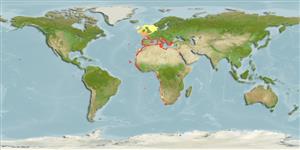Environment: milieu / climate zone / depth range / distribution range
Ecology
Marine; brackish; demersal; non-migratory; depth range 20 - 500 m (Ref. 4510), usually ? - 150 m (Ref. 27000). Subtropical; 60°N - 35°S, 26°W - 36°E
Eastern Atlantic: British Isles (rare) to Senegal including Madeira, the Canary Islands, and Cape Verde. Also throughout the Mediterranean except Black Sea. South African species thought to be the same as population in the northeast Atlantic (Ref. 4313).
Size / Weight / Age
Maturity: Lm ? range ? - ? cm
Max length : 50.0 cm TL male/unsexed; (Ref. 4510); common length : 30.0 cm TL male/unsexed; (Ref. 2683); max. published weight: 3.0 kg (Ref. 40637)
Solitary and sedentary over rocky, sandy or muddy bottoms. Feeds on fishes, crustaceans and mollusks (Ref.4570).
Life cycle and mating behavior
Maturities | Reproduction | Spawnings | Egg(s) | Fecundities | Larvae
Hureau, J.-C. and N.I. Litvinenko, 1986. Scorpaenidae. p. 1211-1229. In P.J.P. Whitehead, M.-L. Bauchot, J.-C. Hureau, J. Nielsen and E. Tortonese (eds.) Fishes of the North-eastern Atlantic and the Mediterranean. UNESCO, Paris. Vol 3. (Ref. 4570)
IUCN Red List Status (Ref. 130435)
Human uses
Fisheries: commercial; aquarium: public aquariums
Tools
Special reports
Download XML
Internet sources
Estimates based on models
Preferred temperature (Ref.
123201): 11.1 - 18, mean 14.4 °C (based on 189 cells).
Phylogenetic diversity index (Ref.
82804): PD
50 = 0.5000 [Uniqueness, from 0.5 = low to 2.0 = high].
Bayesian length-weight: a=0.01318 (0.01129 - 0.01539), b=3.02 (2.98 - 3.06), in cm total length, based on LWR estimates for this species (Ref.
93245).
Trophic level (Ref.
69278): 4.3 ±0.5 se; based on diet studies.
Resilience (Ref.
120179): Low, minimum population doubling time 4.5 - 14 years (K=0.08).
Fishing Vulnerability (Ref.
59153): High to very high vulnerability (68 of 100).
Climate Vulnerability (Ref.
125649): Low vulnerability (18 of 100).
Nutrients (Ref.
124155): Calcium = 53 [28, 142] mg/100g; Iron = 0.883 [0.451, 1.747] mg/100g; Protein = 18.9 [17.4, 20.3] %; Omega3 = 0.655 [0.288, 1.774] g/100g; Selenium = 36.4 [15.7, 91.7] μg/100g; VitaminA = 17.6 [5.5, 56.5] μg/100g; Zinc = 0.797 [0.547, 1.183] mg/100g (wet weight); based on
nutrient studies.
